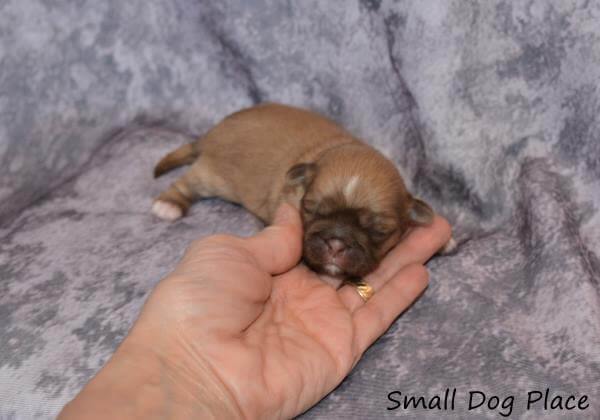Feeding Newborn Puppies: A Complete Guide
By Rachel Hudson |Published May 15, 2019
Taking care of and feeding newborn puppies can satisfy or be disappointing depending on how you approach the matter. It can be challenging if the puppies are orphaned, their mother has abandoned them or she has not produced enough milk to satisfy her entire litter.
Newborn puppy care entails feeding, helping them eliminate, and keeping the animal warm and dry.
 Sleeping in a pile is what puppies love to do.
Sleeping in a pile is what puppies love to do.Description of Newborn Puppies
Newborns or neonates as they are often called, come into this world with their eyes and ears closed. They cannot regulate their body temperature or eliminate on their own.
They have reflexes that allow them to move towards heat sources and to nurse. It is the job of the canine mom to take care of all the needs of her puppies.
If she is unable or unwilling to do this job, that is when you take over to assure the survival of the litter. This entails feeding them, helping them to eliminate, keeping them warm and dry and their area sparkling clean. It also means keeping an eye on them to assure they don't have any adverse reactions to their environment.
How to Feed a Newborn Puppy
To find out whether a puppy is healthy, you need to understand how to take care of a newborn puppy even though the mother is around. Below are tips that will help you feed and guarantee that the puppy develops and grows as it should.
Encourage Mom's Assistance in Feeding Newborn Puppies
The logical way for newborn puppies to get vital nutrients is if the mother feeds them, soon after they are born. This timing is critical because the first milk that a Dam produces is called Colostrum.
Colostrum is rich in maternal antibodies that will protect the puppies until they are old enough to build up their own immune system and receive their first vaccinations.
After whelping, check the puppies to confirm that they are warm and dry. They will be hungry. To guarantee the puppies get plenty of milk, verify that the mother produces enough and regular milk and that it has the right color and texture.
The first milk or colostrum will appear white and slightly watery. After the first couple of days, the milk will continue to be white but somewhat thicker. Any color other than white is a sign of infection.
Make the mother comfortable because if she senses a threat, she might panic and make little milk. A stressed mom will cause stress in the newborns making it more challenging for you to rear.
Some new mothers might be too nervous, and they might attempt to move the puppies to a different location which might be dangerous especially if it is cold or drafty.
Some puppies who have a strong suckling instinct can get separated from their litter mates when mom leaves the whelping box. These puppies refuse to let go of the nipple and get dragged out of the nest when the mom leaves.
If this happens, pick the puppy up and place her back where she belongs. If the puppy feels cold to the touch, you will want to assure that either the mom warms the pup or you will need to do so. One way to warm her body is to place her directly against your skin.
Other factors that might cause the mother to produce an inadequate milk supply include infections, parasites or dehydration. Help the mother by providing fresh water at all times, and if she rejects this, you can try a bowl of soup or add additional water or broth to her food. If none of these work, consult a veterinarian.
 Feeding Newborn Puppies requires work and dedication.
Feeding Newborn Puppies requires work and dedication.Signs of Unhealthy Puppies
Newborn puppies spend most of their days sleeping or feeding. If they cry after feeding, this may be a sign they are unwell or the mother may not be producing enough milk.
Likewise, the milk could be infected because of maternal infection. Pups are vulnerable to diseases, because of their undeveloped immune system. It takes very little to make them sick and sometimes these infections can be fatal.
Supplementary Feeding Techniques
 This little guy has not yet opened his eyes or ears.
This little guy has not yet opened his eyes or ears.If the mother’s milk is inadequate, you will need to supplement. Choose nursing formulas that contain essential nutrients and feed the puppies every two hours.
The formula should contain Omega-3 fatty acids and DHA which helps in the healthy development of the puppy’s eyes and brain. Some formulas will also contain prebiotics or probiotics. Remember to follow the product’s instructions to avoid mixing the wrong amounts.
Bottle Feeding Newborn Puppies
Supplies for Feeding Newborn Puppies
Bottle feeding puppies requires a bottle and your preferred formula. These supplies can be sourced from the pet store or from the veterinarian or purchased online. Very tiny puppies may do better with an eye dropper or even a small syringe.
You will need a can of commercially prepared formula, either liquid or powder
- Assortment of nipples
- Nursing bottle
- Syringe or dropper (optional)
- Glass container to hold prepared formula
- Small towel
Esbilac makes both dog and cat formulas. This one uses goats milk replacer rather than cows milk. Both are available from Amazon.
Miracle Nipple Mini is an excellent choice because it gives you the flexibility of both a nipple and a syringe. This size is good for a small dog, but other sizes are available.
Plastic bottle kits are very inexpensive but if you purchase one, be sure to find one that has a bottle brush. Formula can get caked up inside the bottle and the nipple.
Puppies are sensitive and should be handled with care. Refrain from feeding the pup cow’s milk as it causes diarrhea and sinus problems because of the higher lactase levels.
Cow’s milk is lower in protein, calories, fat, calcium, phosphorus, and carbohydrates which makes it a poor choice for newborn puppies. Commercially available milk replacers come in either liquid or powdered forms and often use goat’s milk as a base.
Preparing the Formula
To prepare the formula, combine 1 part formula with 2 parts water then shake until all the content has dissolved. Store the leftovers in the fridge but remember to warm before feeding. Keep unused formula in a glass container in the refrigerator for no longer than 48 hours.
Newborns who can nurse will drink milk from the mother whose body temperature on average is between 100 and 101 degrees F. This is the temperature that your formula should be. Warm the food, but assure it is not hot.
You can always test the temperature by placing a drop or two on your wrist. If it feels hot to you, then allow it to cool before feeding.
Feeding Newborn Puppies: Best Practices
Hold the puppy in such a way as to allow her to lay on her belly. Other positions may cause her to choke. If the puppy does not like the bottle, apply pressure on the mouth and squeeze a drop to see their reaction.
If the puppy is too weak to drink from the bottle, use the dropper or syringe but administer the formula very slowly so none is inhaled. If after numerous attempts to feed, the puppy is not taking any milk, call your veterinarian.
You may need to tube feed them which requires additional supplies that you can get from a vet. Do not attempt this procedure unless you have been instructed by a vet, vet tech, or knowledgeable breeder.
Homemade Formula if Commercial Formula is Not Available
In a pinch, if you can't get to the store and the puppies need to eat, you can prepare a homemade formula until you can get a commercial one. This formula was provided by Heather Prendergast in Small Animal Pediatrics 1
4 oz. whole cows milk
4 oz. water
2 egg yolks
1 tsp. vegetable oil
500 mg calcium carbonate (Tums)
The formula is approximately 1.2 kcal/ml. A 0.55 kg puppy would need about 60 ml/day, divided over 8 feedings.
Feeding newborn Puppies Timing and Schedules
Establish a feeding schedule to remind you when to feed. Feed every 2 to 3 hours, and that means around the clock. Check the package label to determine approximately how much to feed. The puppy will let you know when it is finished eating by pushing away or falling asleep.
Weaning and Puppy Food
The first 4 weeks are crucial for the pups; that is why it is necessary for them to continue nursing or bottle feeding. After this, you can try incorporating newborn puppy food; this transition should take at least 3 weeks.
At 8 weeks, the pup should be able to consume a solid food diet. Before feeding the dog, ensure that you get the best dog food for sensitive stomach to protect your puppy’s gut.
Feeding Newborn Puppies: Tutorial
The food has to be mixed with water or formula to make it easy for the puppies to eat. Remember they don’t have teeth initially and won’t be able to manage hard kibble.
The addition of probiotics or prebiotics will introduce good bacteria into their gut and help with digestion.
When transitioning, the first few days should be supplemented with formula milk. Give the milk with all meals and then reduce the frequency of the bottle or allow the puppies to nurse if the mom is able.
At 6 weeks the pup can eat 4 times a day, and it would be fun to introduce newborn puppy games to keep him active. As they near their 8 week birthday, you may be able to reduce feedings to three times a day. You will need to continue using soft food until the puppies have gotten their first set of teeth, usually around 9 weeks of age.
The Growing Puppy Diet
 These six week old puppies are learning to eat solid food.
These six week old puppies are learning to eat solid food.Puppies need a balanced diet for proper growth and development. Although there are many foods in the market, the owner ought to confirm that they meet the correct nutritional requirements.
Commercial newborn puppy food should be purchased according to age, size, and breed of the pup. These commercial feeds can be consumed for up to 12 months in small breed dogs. Large breeds should eat their unique formula to avoid developmental issues.
Puppy foods come in a variety of different forms. Remember pups and adult dogs don’t require the same supplements or minerals; therefore, don't feed your puppy adult formulas.
General foods such as those not specified whether for adults or pups should be bypassed.
Puppy Infections and Immunity
Maternal milk is nutritious and beneficial to a puppy, during the first few days. The colostrum contains antibodies which protect the pup from contracting diseases and infections.
These antibodies can only protect the puppy from viruses the mother has acquired an immunity therefore, confirm that she gets vaccinated before she becomes pregnant.
Vaccinations
After 6-8 weeks, the antibodies protection begins to wear off which increases the pup’s vulnerability to diseases. You should consider vaccination at this period to prevent diseases such as hepatitis, influenza, canine diseases, and rabies.
In case the pups are orphaned, or the mother abandons them, vaccination should start as early as 4 weeks, although, the vet can recommend the right time.
Intestinal Parasites
Pups suffer from intestinal parasites more than any other infection if you notice that the puppy passes bloody stool, lacks appetite, and has a dry coat visit the veterinarian for proper examination.
A regular worming schedule beginning at 2 weeks and continuing every two weeks until about 10 weeks will take care of most worms.
Caring for the Mother
It is very important that you care for the mother as well as the puppies.
Caring for the mom means...
- Provide a high-quality diet in sufficient quantities
- Assure adequate water at all times
- A warm environment, but not too hot
- A Comfortable litter box for the puppies and room for her to lay down and nurse
- A place for mom to get away from the puppies
- Lots of TLC
Health Concerns of the Mother
Several conditions that can affect a new mother to the detriment of the puppies include eclampsia and mastitis. Both are painful, and eclampsia is life threatening to the mother
Eclampsia
One such life threatening condition is eclampsia. Eclampsia is an emergency medical condition liked to a sudden drop in blood calcium levels.
Eclampsia occurs when the mom is milk production is at the highest point when the puppies are one to four weeks of age. You may have heard it referred to as Milk Fever or hypocalcemia. Poor diet and large litters are often the reason this problem.
This condition causes muscle spasms, abnormal movements, stiff limbs, and difficulty breathing. This disease is severe and can cause death within an hour. Consult a vet if you notice any of the symptoms
Mastitis
Since the mother’s milk contains colostrum and nutrients that provide immunity and help the puppies to grow, it is necessary for you to check that the mother is healthy.
Check each mammary gland to ensure that there is no infections, redness, or discharge. These symptoms may indicate mastitis, a painful inflammation of the mammary glands.
Call the vet as this is an emergency. If the mother develops mastitis, the pups will need to be bottle fed.
Conclusions
Feeding newborn puppies is a delicate activity and should be approached with caution. Neonates are susceptible to many dangers such as cold, hunger, infections, and other canine diseases.
To ensure that your pup grows and develops, it is necessary to learn how to take care of a newborn puppy.
As you focus on the puppy, don’t forget the mother as neglecting her could take a toll on the pups, too.
Provide plenty of TLC for the mom to help her relax to reduce anxiety which might cause them to take actions which could harm the newborns.
We suggest that you learn basic methods of caring for and feeding a newborn puppy before getting one. Share with us your experiences feeding a newborn puppy.
References (Feeding Newborn Puppies)
Small Animal Pediatrics: The First 12 months of Life by Michael E. Peterson and Michelle Anne Kutzler (2011)
Overview of Management of the Neonate in Small Animals (Merck Veterinary Manual)
Author Bio of Feeding Newborn Puppies: A Complete Guide
Rachel Hudson is a blogger whose specialty is domestic dogs. She spends most of her time interacting with pet owners and veterinarians.
She loves reading and researching about man’s best friend so she can learn the best way to care for her two pit-bulls, Labrador and Great Dane.
Feeding Newborn Puppies
This guide about feeding newborn puppies is only meant to be informative and should never replace the care and advice of a licensed veterinarian.
About Janice (author and voice behind this site)
Having lived with dogs and cats most of her life, Janice served as a veterinary technician for ten years in Maryland and twelve years as a Shih Tzu dog breeder in Ohio.
Her education includes undergraduate degrees in Psychology with a minor in biology, Early Childhood Education, and Nursing, and a master's in Mental Health Counseling.
She is a lifelong learner, a dog lover, and passionate about the welfare of animals. Her favorite breed for over 50 years has been the Shih Tzu, but she has also lived with Poodles, Maltese, Yorkshire Terriers, Beagles, English Bulldogs, Carin Terriers, and a Cocker Spaniel.
When not writing, reading, and researching dog-related topics, she likes to spend time with her eight Shih Tzu dogs, husband, and family, as well as knitting and crocheting. She is also the voice behind Miracle Shih Tzu and Smart-Knit-Crocheting
Does This Article Deserve Your Thumbs Up?
We always appreciate your support and encouragement. Your thumbs up means so much to us. Please like this article.
If you find this page or any page on Small Dog Place Helpful, or useful in anyway, I'd love it if you would click the small heart found on the bottom right of each page.
You can also share or bookmark this page -- just click on the:

Free Monthly Newsletter
Sign Up for Our Free Newsletter and get our Free Gift to You.
my E-book, The Top 10 Mistakes People Make When Choosing a Dog (and how to avoid them)

